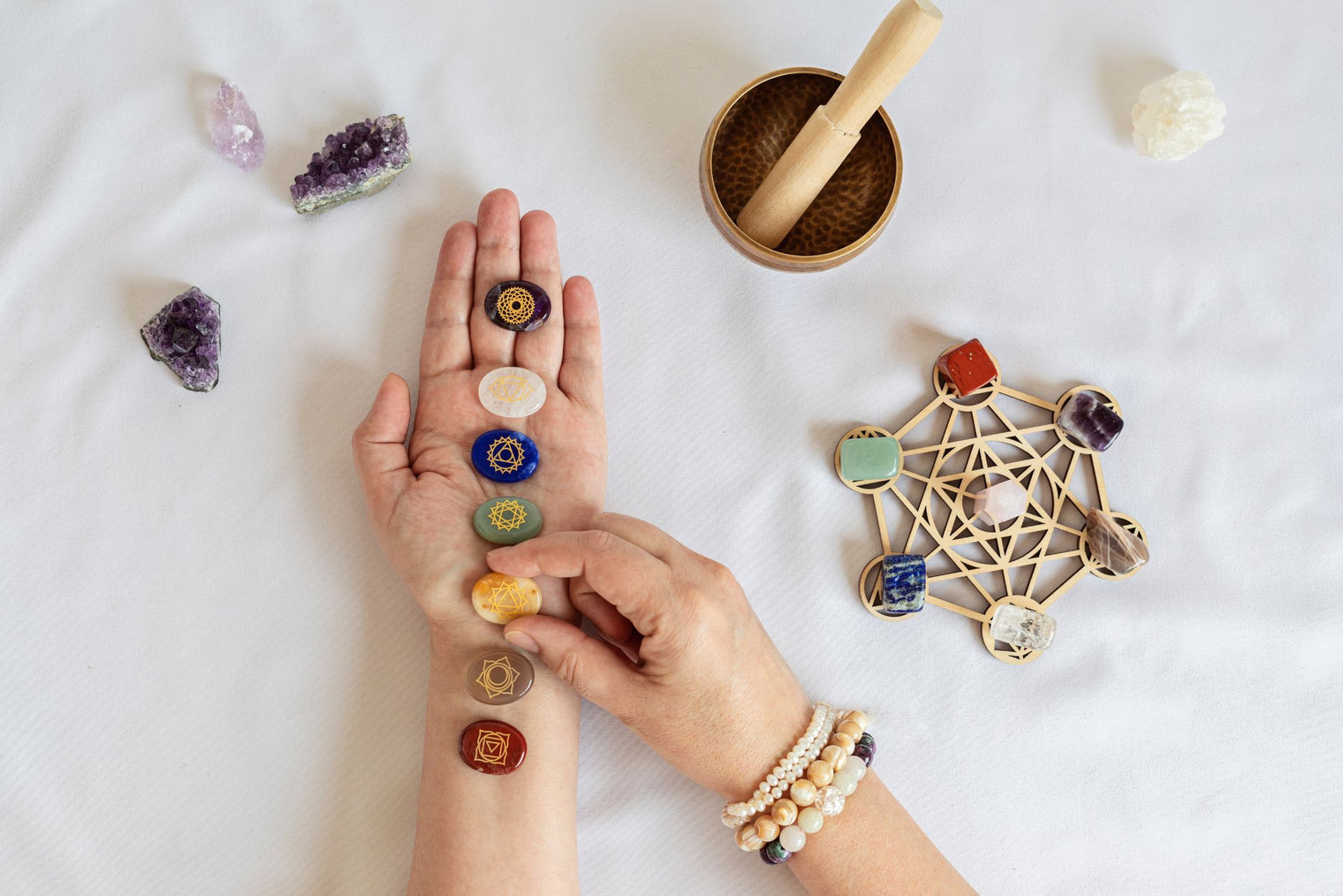In the quest for holistic wellness and spiritual balance, the realm of alternative therapies offers a fascinating landscape. Among these, the use of singing bowls stands out as a powerful tool for restoring harmony within oneself. But what is the connection between these enchanting instruments and the intricate energy centers known as chakras?
Exploring the Chakras: Gateways to Inner Harmony
Before delving into the mesmerizing relationship between singing bowls and chakras, let's unravel the essence of these energy centers. According to ancient Indian philosophy and spiritual traditions, the human body contains seven main chakras, each representing distinct aspects of physical, emotional, and spiritual well-being.
- Root Chakra (Muladhara): Located at the base of the spine, represents stability, security, and belonging. It serves as our grounding force, connecting us to the Earth's energy and providing a sense of rootedness in the physical world. Balanced, it fosters confidence and resilience, while imbalances can lead to insecurity and fear. Practices like meditation and yoga help maintain its equilibrium, ensuring a solid foundation for navigating life's challenges.
- Sacral Chakra (Swadhisthana): Situated in the lower abdomen, governs creativity, passion, and emotional expression. It's depicted as an orange energy center, fostering a deep connection to emotions and desires. Balanced, it brings vitality and joy, while imbalances can lead to intimacy issues and creative blocks. Practices like dance and art help nurture the Sacral Chakra, unlocking creative potential and fostering harmonious relationships.
- Solar Plexus Chakra (Manipura): Positioned in the upper abdomen, embodies personal power, confidence, and self-esteem. It's depicted as a vibrant yellow energy center, empowering us to assert ourselves and pursue goals with determination. Balanced, it fosters resilience and inner strength, but imbalances can lead to low self-esteem and difficulty setting boundaries. Practices like meditation help nurture the Solar Plexus Chakra, cultivating a healthy sense of self-worth and empowering us to manifest our dreams.
- Heart Chakra (Anahata): Nestled in the center of the chest, the heart chakra embodies love, compassion, and forgiveness. It's represented by a green energy center, fostering empathy and connection. Balanced, it promotes harmony and understanding, but imbalances can lead to difficulties in relationships and emotional turmoil. Practices like meditation help nurture the Heart Chakra, fostering compassion and forgiveness towards ourselves and others.
- Throat Chakra (Vishuddha): Located in the throat region, the throat chakra governs communication, self-expression, and authenticity. It's represented by a blue energy center, facilitating honest expression and clear communication. Balanced, it promotes authenticity and openness, but imbalances can lead to issues such as difficulty expressing oneself and feeling misunderstood. Practices like journaling and singing help nurture the Throat Chakra, fostering clear communication and authentic self-expression.
- Third Eye Chakra (Ajna): Found between the eyebrows, the third eye chakra represents intuition, insight, and spiritual awareness. It's depicted as an indigo energy center, facilitating inner wisdom and perception. Balanced, it promotes clarity and spiritual growth, but imbalances can lead to confusion and lack of direction. Practices like meditation and visualization help nurture the Third Eye Chakra, enhancing intuition and deepening spiritual awareness.
- Crown Chakra (Sahasrara): Positioned at the top of the head, the crown chakra signifies higher consciousness, divine connection, and enlightenment. Represented by a violet energy center, it fosters spiritual awakening and unity with the divine. Balanced, it promotes profound wisdom and spiritual fulfillment, but imbalances can lead to feelings of disconnection and spiritual emptiness. Practices like meditation and prayer help nurture the Crown Chakra, fostering a deeper connection to higher realms and facilitating spiritual enlightenment.
Understanding the Flow: Ida, Pingala, and Sushumna

In addition to the seven main chakras, the ancient yogic tradition recognizes the existence of three principal energy channels known as Ida, Pingala, and Sushumna. These channels form the subtle energy system within the body, facilitating the flow of prana (life force energy) and maintaining equilibrium.
- Ida: Ida, representing lunar energy, flows through the left side of the body, fostering receptivity, introspection, and emotional balance. It complements the fiery energy of Pingala, creating harmony within us. When balanced, Ida invites deep reflection and emotional harmony. However, imbalances can lead to emotional instability. Through practices like pranayama and meditation, we can attune to Ida's soothing rhythm, fostering resilience and deepening our inner wisdom.
- Pingala: Pingala, reflecting solar energy, flows along the right side of the body, embodying vitality, action, and dynamism. It complements the receptive nature of Ida. Like the sun's rays, Pingala energizes us, empowering action and passion for life. Balanced, it fosters strength and purpose, but imbalances can lead to excessive ambition. Through practices like yoga, we can harmonize Pingala's flow, channeling its energy into balanced pursuits while nurturing vitality and resilience.
- Sushumna: Sushumna runs along the spine's central axis, serving as the pathway for spiritual awakening, linking individual consciousness with universal consciousness. Revered in spiritual traditions, it facilitates the ascent of Kundalini energy, leading to inner transformation and enlightenment. Through practices like meditation and pranayama, individuals purify and awaken Sushumna, aligning themselves with the divine essence.
7 Chakra Notes:

The concept of chakras is deeply rooted in ancient Eastern philosophies, particularly in Hinduism and Buddhism. Chakras are believed to be energy centers within the human body, each associated with specific physical, emotional, and spiritual aspects of our being. Here's a brief overview of the seven chakras and their corresponding musical notes:
-
Root Chakra (Muladhara) - Note C
- Location: Base of the spine
- Element: Earth
- Represents: Security, stability, survival instincts
-
Sacral Chakra (Swadhisthana) - Note D
- Location: Lower abdomen, below the navel
- Element: Water
- Represents: Creativity, sensuality, emotional balance
-
Solar Plexus Chakra (Manipura) - Note E
- Location: Upper abdomen, stomach area
- Element: Fire
- Represents: Personal power, self-esteem, willpower
-
Heart Chakra (Anahata) - Note F
- Location: Center of the chest, near the heart
- Element: Air
- Represents: Love, compassion, forgiveness
-
Throat Chakra (Vishuddha) - Note G
- Location: Throat
- Element: Ether
- Represents: Communication, self-expression, truth
-
Third Eye Chakra (Ajna) - Note A
- Location: Between the eyebrows, forehead
- Element: Light
- Represents: Intuition, insight, perception
-
Crown Chakra (Sahasrara) - Note B
- Location: Top of the head
- Element: Consciousness
- Represents: Spirituality, enlightenment, connection to the divine
Each chakra is associated not only with a musical note but also with specific colors, symbols, and psychological characteristics. The idea behind using sound, such as singing bowls, to resonate with these chakras is to help balance and align the energies within the body, promoting physical, emotional, and spiritual well-being.
When using singing bowls or other musical instruments tuned to these specific frequencies, practitioners believe they can help harmonize and activate the corresponding chakras, facilitating a sense of balance and vitality in one's life.
Understanding the Chakras: Pathways to Inner Harmony
In this exploration, we'll uncover the ancient wisdom behind the seven chakras and their profound influence on our physical, emotional, and spiritual lives. From the foundational root chakra to the transcendent crown chakra, each energy center holds a unique resonance that mirrors the frequencies of singing bowl notes.
Chakras, stemming from ancient Indian philosophy and spirituality, are subtle energy centers believed to govern various aspects of our being. Below is a table illustrating the seven chakras, their English and Vedic names, along with key attributes:
|
English Name |
Vedic Name |
Symbol |
Location |
Mantra |
Color |
Area it Affects |
Balanced Benefits |
Notes |
|
Root Chakra |
Muladhara |
 |
Base of the spine |
Lam |
Red |
Stability, security, survival instincts |
Groundedness, security |
C |
|
Sacral Chakra |
Swadhisthana |
 |
Lower abdomen |
Vam |
Orange |
Creativity, passion, emotional expression |
Creativity, emotional balance |
D |
|
Solar Plexus Chakra |
Manipura |
 |
Upper abdomen |
Ram |
Yellow |
Personal power, confidence, self-esteem |
Self-confidence, empowerment |
E |
|
Heart Chakra |
Anahata |
 |
Center of the chest |
Yam |
Green |
Love, compassion, forgiveness |
Compassion, emotional healing |
F |
|
Throat Chakra |
Vishuddha |
 |
Throat region |
Ham |
Blue |
Communication, self-expression, authenticity |
Clear communication, self-expression |
G |
|
Third Eye Chakra |
Ajna |
 |
Between the eyebrows |
Om/Aum |
Indigo |
Intuition, insight, spiritual awareness |
Intuition, clarity of mind |
A |
|
Crown Chakra |
Sahasrara |
 |
Top of the head |
Om/Aum |
Violet |
Higher consciousness, divine connection |
Spiritual connection, enlightenment |
B |
Conclusion: Embracing Harmony and Wholeness
In the tapestry of existence, the interplay between sound, energy, and consciousness weaves a profound symphony of healing and transformation. Through the timeless resonance of singing bowls, we embark on a sacred journey of self-discovery, harmonizing the rhythm of our being with the cosmic dance of existence.
As we attune to the subtle melodies that reverberate within and without, may we embrace the profound interconnectedness of all things and awaken to the radiant essence of our true selves.
In the enchanting alchemy of sound and spirit, let us embrace the harmony that resides within and rediscover the boundless depths of our inner universe.
By seamlessly blending the essence of chakras, the flow of energy channels, and the enchanting allure of singing bowls, this blog aims to captivate readers' interest while providing valuable insights into the profound connection between ancient wisdom and modern healing modalities. Through its accessible language and engaging narrative, the blog endeavors to spark curiosity, foster understanding, and inspire readers to embark on their own journey of holistic well-being.

